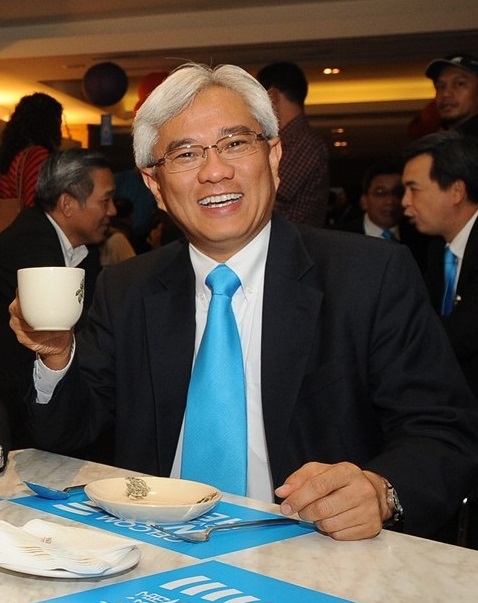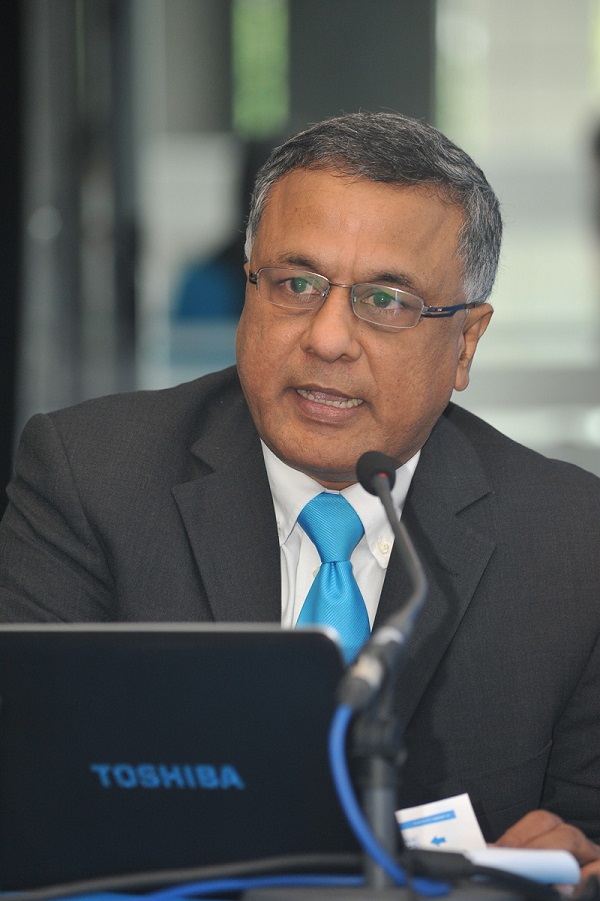Axiata CEO optimistic despite mobile competition from TM
By Goh Thean Eu August 28, 2014
- Company unfazed by entry of new player in mobile space
- Revenue grows 1.5% in first half, but net profit falls 11%

WITH fixed-line giant Telekom Malaysia Bhd (TM) making inroads into the mobile space, some industry observers may feel that the rice bowl of mobile operators may be under threat, given that mobile pie will have to be sliced up amongst more players.
However, regional telecommunications player Axiata Group Bhd does not believe that the scenario is as bleak as that. According to its president and group chief executive officer Jamaludin Ibrahim, there are two ways to look at the increasing convergence of fixed and mobile services.
“On the one hand … [there] is no denying what TM is doing to the mobile space by offering mobile Internet services. But don’t forget, we are also using its high speed broadband (HSBB) platform to launch fixed broadband services over TM’s network, and in a way, competing with TM,” he told a media briefing in Kuala Lumpur on Aug 27.
“So, everyone is competing with each other. If you look at that angle, then you will be concerned,” he said.
READ ALSO: TM sees 8% revenue growth, expects a ‘game-changing’ year
Instead, one should look at the bigger picture of the industry, he argued, as the convergence trend means that the size of the market will eventually get larger.
 “If you look at the much broader angle, this industry is actually getting much bigger. So, there is mobile, there is fixed, there is broadband and also digital services. The cake itself is actually growing,” Jamaludin (pic) said.
“If you look at the much broader angle, this industry is actually getting much bigger. So, there is mobile, there is fixed, there is broadband and also digital services. The cake itself is actually growing,” Jamaludin (pic) said.
“The question is no longer about going into each other’s territory, it’s more about who is taking a bigger chunk of that bigger cake that is also growing … at a pace faster than we can actually digest.
“So it is good news actually,” he claimed.
While the size of the cake may be growing, it does not mean that Axiata, the parent company of Celcom Axiata Bhd, is resting on its laurels, he said. There needs to be a “mindset change” by mobile players.
“Right now, most of us in Malaysia spend about 5% of our income on telecommunications. But what happens to the other 95%? Can I grab a small piece of the broadband? Can I grab a piece of digital commerce?
“We are trying to grow from that angle,” Jamaludin told the media during the announcement of Axiata’s first half financial results.
Most Axiata companies performing
For the second quarter ended June 30, 2014, Axiata registered a net profit of RM447.82 million, about 30% lower than the RM644.78 million in the same quarter last year. Quarterly revenue gained marginally at 2% to RM4.73 billion, versus RM4.63 billion a year ago.
[RM1 = US$0.32]
For the six-month period, net profit dipped 11% to RM1.12 billion versus RM1.26 billion last year. Revenue during the first half rose marginally to RM9.25 billion from RM9.11 billion in the first half of 2013.
Axiata’s Earnings Before Interest, Tax, Depreciation and Amortisation (EBITDA) for the first half also fell by 3% to RM3.53 billion.
Jamaludin attributed the lower net profit to higher unrealised foreign exchange losses. Taking out the impact of foreign exchange losses, the company would have registered a 0.3% growth in its EBITDA and its net profit would have registered a 3% decline.
In terms of revenue, most of Axiata’s operating companies performed well during the quarter, with the exception of Celcom, he said.
 Axiata group chief financial officer Chari TVT (pic) said that Celcom, which initially had a headline key performance indicator (KPI) target of mid-single-digit revenue growth, would find it a challenge to meet that target.
Axiata group chief financial officer Chari TVT (pic) said that Celcom, which initially had a headline key performance indicator (KPI) target of mid-single-digit revenue growth, would find it a challenge to meet that target.
For the first half, Celcom’s revenue fell by 3% to RM3.86 billion, while net profit fell by 8% to RM1.03 billion.
The decline was mainly due to its ongoing IT transformation programme, which has somewhat affected its momentum on customer acquisition as well as dealers’ confidence, said Chari.
Revenue also took a beating partly because of the suspension of promotions via short codes. This segment represents about 1% to 3% of Celcom’s revenue, added Jamaludin.
Other factors contributing to the lower first-half net profit was Celcom’s high staff costs, due to higher ESOS (employee share option scheme) payouts as well as salary increments.
“The good news is that Celcom managed to register revenue and net profit growth quarter-on-quarter,” said Jamaludin.
However, he cautioned that Celcom may be still under revenue pressure in the third quarter, but said he believes that the company will regain its growth momentum once the IT transformation programme is completed.
Celcom, which contributes to about 42% of the group’s total revenue, also spent RM300 million on capital expenditure (capex) in the first half of this year, significantly lower than the RM407 million capex it spent in the first half of last year.
Across the region

Jamaludin said that the 'star performer” of the group for the first half was Smart (pic above), its Cambodia unit.
During the period under review, Smart’s revenue increased by 35%, while EBITDA and normalised net profit jumped 78% and 81%, respectively. Its subscriber base increased by 35% to 5.9 million.
“What’s encouraging is that Smart posted a year-to-date data revenue growth of 115%, with data contributing 19% of its total revenue. It is a sign of good growth ahead,” said Jamaludin.
Bangladesh’s Robi also registered a strong performance, with year-to-date revenue, EBITDA and normalised net profit growing 7%, 14% and 8%, respectively. It also managed to improve its EBITDA margin by 2.6 percentage points to 39.8% during the first half.
“That’s pretty good margin. Although competition has heightened in Bangladesh, it is still under control,” Jamaludin said.
Indonesia’s XL Axiata, the group’s second largest revenue contributor with 35%, managed to grow its revenue and EBITDA by 12% and 2% to 11.6 trillion rupiah and 4.2 trillion rupiah, respectively.
In terms of the bottomline, XL Axiata recorded a net loss of 483 billion rupiah, versus a net profit of 670 billion rupiah in the first half of last year.
The net loss was mainly due to the weakening of the rupiah versus the US dollar, and higher interest expenses from additional loans related to its acquisition of Axis. Most of XL Axiata’s loans are in US dollars, meaning it would need to fork out more rupiah to service its debts when the US dollar strengthens.
[1 million rupiah = US$85.32]
As of the first half, XL Axiata had a net debt of 27.8 trillion rupiah, versus 15.18 trillion rupiah in the same period a year ago.
Mergers and acquisitions
On the rumours that China Mobile was interested in buying a stake in Axiata, Jamaludin said that he has not been contacted by anyone on that matter.
“No one has spoken to me on that. Also, we are not in any need for cash at this level,” he said.
In fact, for the second quarter ended June 30, 2014, Axiata’s ‘gearing level’ (debt/ EBITDA) was at 2.02 times.
“Anything below the 2.3-2.5x level is good. It gives us a lot of headroom to borrow more when necessary,” said Chari.
Jamaludin also said that the company is reviewing its operations in Pakistan, which is Multinet, a fibre cable network company.
He said Axiata had initially expressed an interest in divesting its stake in Multinet. However, thanks to the launch of 3G (third generation) technology there, the group now expects Multinet's business to improve significantly, driven by the growing demand for data.
He said that the company will not be looking at divesting its stake in Multinet for now, and will look into it again come the first quarter of next year.
Related Stories:
The wireless giant in Telekom Malaysia awakens
Axiata manages to post growth despite Indonesian setback
Axiata starts its ‘digital company’ reinvention
Suresh Sidhu of Celcom takes charge of Axiata subsidiary e.co
New line-up for Celcom’s C-level suite
For more technology news and the latest updates, follow us on Twitter, LinkedIn or Like us on Facebook.


